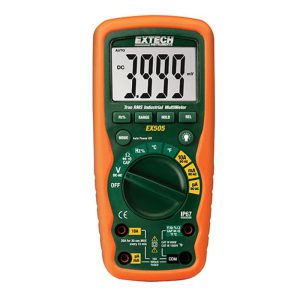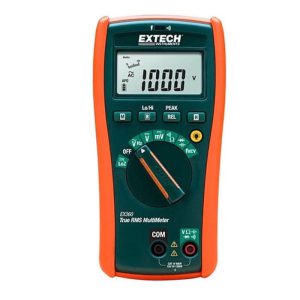Table of Contents
ToggleComprehensive Reviews of 2 EXTECH Multimeter: How to Pick the Best,for Your Needs
How do you pick the right multimeter for your needs?
Multimeters come in a wide variety of models, each with its own features, uses, and price range. How can you tell which one is ideal for your requirements?
Before purchasing a multimeter, you should take into account a few things, such as:
The characteristics and capabilities you require.
The preciseness and clarity you need.
The robustness and security you demand.
The amount of money you have
Let’s take a closer look at each element.
Features and functions
What features and functions you require from your multimeter should be your first priority. Your application may require more or fewer capabilities and functions.
For instance, you might not require a multimeter with a lot of features and capabilities if you only need to measure fundamental quantities like voltage, current, and resistance. However, you might require a multimeter with more features and functions if you need to measure more complex parameters like temperature, duty cycle, and frequency.
The following are some typical features and capabilities of multimeters:
True RMS: With the aid of this capability, the multimeter is able to precisely gauge AC voltage and current in any waveform, not just sine waves.
This is crucial if you work with distorted or noisy signals, including those produced by electronic devices, inverters, or variable speed drives.
Temperature: Using a Type K thermocouple probe (included or available separately), the multimeter can measure temperature using this function. This is helpful for inspecting motors, transformers, or heating and cooling systems.
Duty cycle: With the use of this feature, a multimeter is able to calculate the proportion of time that a signal is on or off during a cycle. The pulse width modulation (PWM) signals from dimmers or motor controllers can be checked with this.
Measure the number of signal cycles per second using the multimeter’s frequency function. This is helpful for inspecting oscillators or signal generators.
Some multimeters have dual sensitivity frequency functions that can measure both low- and high-frequency electrical and electronic signals, such as radio waves and power lines.
Without touching the wires or terminals, the multimeter can detect the presence of AC voltage thanks to this capability, known as a non-contact voltage detector (NCV). When voltage is detected, an LED indicator on the device illuminates. For ease and safety, this is helpful.
Data hold: With this function, the multimeter can freeze the displayed reading for later review. When you need to record the measurement or the display is difficult to see, this is helpful.
Peak hold: During a measurement, this feature enables the multimeter to record the highest or lowest reading. When you need to detect voltage or current spikes or dips, this is helpful.
The multimeter can conserve battery life by turning off automatically after a predetermined amount of idleness. If you don’t want this functionality, you can typically disable it.
The multimeter may zero out the metre or adjust offsets using the relative mode capability. When you need to measure the difference between two values or get rid of the influence of test leads or probes, this is helpful.
The multimeter you select should have the capabilities and functions your application requires. The multimeter’s usability and user interface are other important factors to take into account.
For instance, you should seek out a multimeter with an easy-to-read display, user-friendly buttons and knobs, and an instruction booklet.
Resolvency and accuracy
The second item to think about is the level of precision and resolution you need from your multimeter.
How closely the measured value matches the true value is known as accuracy. The resolution of a multimeter refers to how many digits and decimal places it can show.
A multimeter’s accuracy and resolution are influenced by a number of variables, including the calibre of its parts, its calibration, and the surrounding environment.
A multimeter’s accuracy and resolution are often represented as a reading % plus a certain number of counts or digits.
For instance, if a multimeter has a resolution of 4,000 counts and an accuracy of 0.5% + 2 counts, that means that:
The measurement error can be up to two counts plus 0.5% of the true number.
The multimeter can show four digits or up to 4,000 counts.
Therefore, if you use this multimeter to measure 100 V, the true reading will range between 99.48 V and 100.52 V (0.5% of 100 V plus 2 counts), and the display will show any reading between 0994 and 1005 (4,000 counts).
A multimeter is more accurate and detailed the higher its accuracy and resolution. Higher resolution and accuracy come at a higher price and with more complexity. You should pick a multimeter with just the right amount of accuracy and resolution for your application.
Examining the specs of the circuit or device that you wish to measure is a useful way to establish the accuracy and resolution that you require. You should pick a multimeter that meets or exceeds those standards in terms of accuracy and resolution.
For instance, you should pick a multimeter with accuracy of at least 5% if you wish to measure a resistor that has a tolerance of 5%. Select a multimeter with a resolution of at least 1 nF (0.001 F) if you want to measure a capacitor with a capacitance of 10 F.
Safety and resilience
The next factor to think about is the level of security and sturdiness you anticipate from your multimeter. The multimeter’s durability refers to how well it can tolerate physical stress, such as drops, impacts, infiltration of water and dust.
The multimeter’s ability to safeguard both you and itself against electrical risks including overvoltage, overcurrent, short circuits, and electric shocks is what constitutes safety.
The strength and security of a multimeter depend on a number of elements, including the calibre of the materials, the housing’s design, and the safety features.
The IP certification and CAT rating of a multimeter typically serve as indicators of its robustness and safety.
Category rating is referred to as the CAT rating. The highest voltage level that the multimeter can safely measure in various electrical situations is indicated by a Roman numeral.
The CAT rating scales from CAT I to CAT IV and is based on several electrical circuit types.
If a multimeter, for instance, has a CAT rating of CAT III 1000 V, this indicates that:
In CAT III circuits, it can safely measure up to 1000 V.
In CAT I and CAT II circuits, it can also measure lower voltage levels safely.
Low-voltage, low-energy CAT I circuits, such those in batteries, electronics, and signal generators, are not connected to the mains supply.
Appliances, tools, and lighting are examples of CAT II circuits, which are low-voltage, high-energy circuits connected to the mains supply at the outlet level.
High-voltage, high-energy CAT III circuits include breakers, motors, and transformers that are connected to the mains supply at the distribution level.
The mains supply is connected to high-voltage, high-energy CAT IV circuits at the source level, such as utility poles, overhead lines, and service entrances.
A multimeter is more reliable and safer the higher its CAT rating. more CAT ratings are associated with more expense and complexity, though.
The voltage level and energy level of the circuits you are measuring should be compatible with the CAT rating of the multimeter you use.
For instance, you might not require a multimeter with a high CAT rating if you solely measure low-voltage and low-energy circuits.
However, you might require a multimeter with a high CAT rating if you’re measuring high-voltage and high-energy circuits.
Budget
The budget you have for your multimeter is the fourth factor you should take into account. The functions, features, accuracy, resolution, durability, and safety of a multimeter all have a role in its price.
A multimeter will cost more the more features, functions, accuracy, resolution, durability, and safety it has. For your purposes, you should pick a multimeter that has the optimum performance/price ratio.
Taking a look at the costs of various models available on the market is a smart method to figure out the budget you require for your multimeter.
On the website mme-ae.com, you may compare the costs and features of several models to get a sense of what you can buy for your money.
For instance, you can see that the pricing of the two models we are reviewing in this post, the EXTECH EX505 and the EXTECH EX360, differ.
The EXTECH EX505 costs AED 1,004 (about $273), while the EXTECH EX360 costs AED 563 (approximately $153), according to the website mme-ae.com.
The EXTECH EX505’s increased pricing reflects its superior performance and features.
You should pick a multimeter that is affordable and matches your requirements. A multimeter that is either pricey or too cheap for your purpose shouldn’t be purchased.
A cheap multimeter might not have enough features and functionalities, or it might not be accurate and precise enough, or it might not have adequate durability and safety.
It’s possible that an expensive multimeter has more features and capabilities than you need, or that it has higher accuracy and resolution than you need, or that it’s simply not worth the extra money.
The EXTECH EX505 and the EXTECH EX360 are contrasted.
The aspects you should think about before purchasing a multimeter have now been covered, so let’s compare the two models that we will be comparing in this post, the EXTECH EX505 and the EXTECH EX360.
In terms of features, functionalities, accuracy, resolution, durability, and safety, we will compare and contrast them.
Similarities
True RMS multimeters that can measure AC/DC voltage and current, resistance, capacitance, frequency, diode test, and continuity are the EXTECH EX505 and EXTECH EX360.
Additionally, they have an integrated non-contact voltage detector (NCV) with features like a relative mode, auto power off, data hold, and peak hold. They are packaged with a carrying case, a 9V battery, and test leads.
Most multimeters have these fundamental features and capabilities. They can be used to measure a variety of electrical properties in various devices and circuits.
Additionally, they make the multimeters portable and simple to use.
Differences
In comparison to the EXTECH EX360, which has 8 functions and 0.8% basic accuracy, the EXTECH EX505 offers 11 features and a 0.5% basic accuracy.
A multimeter is more versatile and accurate the more functions and better accuracy it has.
With a Type K bead wire probe, duty cycle, and dual sensitivity frequency (electrical/electronic), the EXTECH EX505 can measure temperature.
These extra features are beneficial for a variety of applications. You can examine motors, transformers, heating or cooling systems, and other devices using the temperature function.
You can use the duty cycle function to test pulse width modulation (PWM) signals from dimmers or motor controllers.
You can measure both low-frequency electrical signals (like power lines) and high-frequency electronic signals (like radio waves) using the dual sensitivity frequency function.
These features are absent from the EXTECH EX360.
The EXTECH EX360 sports a 6,000-count white LED backlit display, compared to the EXTECH EX505’s 4,000 count big backlit LCD display.
The display can display more digits and resolution due to the increased count. The display is easier to view in low light thanks to the backlight.
The EXTECH EX505 sports a magnetic hanging strap and a double-molded housing for waterproof protection.
The multimeter is more enduring and impervious to dust and intrusion due to the double-molded casing. For hands-free use, you can affix the multimeter to a metal surface using the magnetic hanging strap.
A holster with a tilt stand and built-in magnet is included with the EXTECH EX360. The multimeter is shielded from impacts and scratches by the holster.
You may support the multimeter on a flat surface with the tilt stand for simple viewing. You may also connect the multimeter to a metal surface with the help of the built-in magnet for hands-free use.
The two models’ prices are also different. The EXTECH EX505 costs AED 1,004 (about $273), while the EXTECH EX360 costs AED 563 (approximately $153), according to the website mme-ae.com. The EXTECH EX505’s greater pricing reflects its better features and performance.
Conclusion
Both the EXTECH EX505 and the EXTECH EX360 are excellent True RMS multimeters with a range of electrical parameters they can measure.
However, there are some distinctions between them in terms of features, functions, accuracy, and durability as well as safety.
The EXTECH EX505 can be a good option if you require a multimeter with more measurement capabilities, greater accuracy, and longer durability.
For a variety of applications, it can measure temperature, duty cycle, and dual sensitivity frequency. A big backlit display and a weatherproof casing are key features.
The EXTECH EX360 multimeter can be a good option if you need one that is more inexpensive and portable.
It has more count displays than the EXTECH EX505 and the fundamental features seen in most multimeters.
For added convenience, it incorporates a holster with a tilt stand and a magnet.
The ideal multimeter for you ultimately depends on your requirements, tastes, and financial situation.
To compare the features and customer opinions of the two versions, visit the website mme-ae.com.
If you have any inquiries or require any assistance, you can also get in touch with their customer support.
We hope that this information will aid in your selection of the ideal multimeter.
Please spread the word about this article to friends and coworkers who might be interested in multimeters if you enjoyed it. I appreciate you reading.




